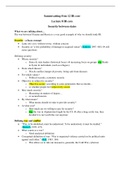Samenvatting
Summary Core Module - International Relations (Core IR) Lecture 8-12
A very extensive summary of the lectures 8-12 of the Core Module - International Relations course. This contains everything that was discussed in the lectures and at the same time incorporates the literature. I completed the course with a 8.6 average and everything you need to know is in the summar...
[Meer zien]




